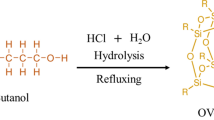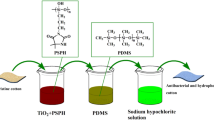Abstract
The primary objective of modifying cotton fabric was to impart bactericidal properties to attract various fields such as defence, space and textile industrial applications. Chemically initiated graft copolymerization of 4-vinyl pyridine (4-VP) and acrylonitrile (AN) onto cotton fabric was carried out using ceric ammonium nitrate as a redox initiator. Optimum conditions pertaining to maximum percentage of grafting were evaluated as a function of concentration of initiator [CAN], concentration of nitric acid, monomer concentration, water, temperature and reaction time. Maximum grafting of 4-VP (51.63%) and AN (69.23%) was obtained respectively at optimum \( \left[ {\text{CAN}} \right] = 2.738 \times {10^{ - 2}} \) and 2.19 × 10−2 moles/L, \( \left[ {4 - {\text{VP}}} \right] = 47.55 \times {10^{ - 22}}{\text{moles}}/{\text{L}} \), \( \left[ {\text{AN}} \right] = 18.85 \times {10^{ - 22}}{\text{moles}}/{\text{L}} \), \( \left[ {{\text{HN}}{{\text{O}}_3}} \right] = 11.9 \times {10^{ - 2}} \) and 89.5 × 10−22 moles/L in 20 and 25 ml of water at an optimum temperature 70 °C and 60 °C with in 180 and 120 min. Antibacterial properties were induced into the modified cotton fabric by treating the grafted fabric with benzyl chloride. The grafted and quaternized copolymer were characterized by FTIR and Thermogravimetrical analysis. The bactericidal action of cotton fabric was tested by filtration test and it was observed that fabric grafted with 4-VP was more effective and efficient antibacterial as compared to AN grafted cotton sample.


















Similar content being viewed by others
References
Makal U, Wood L, Ohman DE, Wynne K (2006) J Biomaterials 27:1316–1326
Shahidi S, Ghoranneviss M, Moazzenchi B, Rashidi A, Mirjalli M (2007) Plasma Proc Polym 4(S1):S1098–S1103
Ren X, Kocer HB, Worley SD, Broughton RM, Huang TS (2009) Carbohydr Polym 75(4):683–687
Cucchi I, Boschi A, Arosio C, Bertini F, Freddi G, Catellani M (2009) Synth Met 159(3–4):246–253
Gupta P, Bajpai M, Bajpai SK (2008) J Macromol Sci, Part A 45(2):179–185
Hou A, Zhou M, Wang X (2009) Carbohydr Polym 75(2):328–332
Hong KH, Sun G (2008) Carbohydr Polym 71(4):598–605
Ma Y, Zhou T, Zhao C (2008) Carbohydr Res 343(2):230–237
Nasr HE, Sayyal SM, Essa DM, Sambha SH, Rabic AM (2009) Carbohydr Polym 76(1):36–45
Canal C, Gaboriau F, Villeger S, Cvelbar U, Richard A (2009) Int J Pharm 364(1–2):155–161
Tomoic B, Simoncic B, Orel B, Zerjav M, Schroers H, Simoncic A, Samardzija Z (2009) Carbohydr Polym 75(4):618–626
Acknowledgement
One of the authors Ms. Bharti Sharma is grateful to the University Grant Commission, New Delhi, for providing Junior Research Scholarship.
The author is also thankful to Inter-University Acceleratory Centre, New Delhi for providing financial assistance.
Author information
Authors and Affiliations
Corresponding author
Rights and permissions
About this article
Cite this article
Kaur, I., Bhalla, T.C. & Sharma, B. Functionalization of cotton fabric orienting towards antibacterial activity. J Polym Res 18, 347–358 (2011). https://doi.org/10.1007/s10965-010-9424-2
Received:
Accepted:
Published:
Issue Date:
DOI: https://doi.org/10.1007/s10965-010-9424-2




